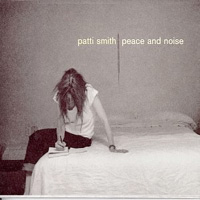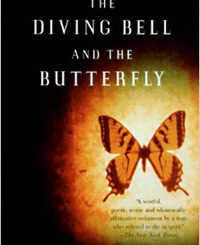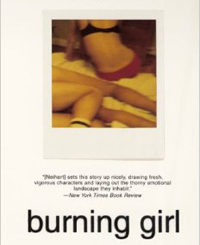 Patti Smith
Patti Smith
Peace and Noise (Arista)
by Thomas Christian
Whereas Gone Again announced Patti Smith’s grand return to the public eye with the crack of a loud snare, Peace and Noise , her second release in as many years and seventh overall, opens with dreamridden seaside distorto-chords and spooky humms. A bright piano breaks like sunrise, and the voice pours out to chant, babble, growl and lullabye.
She has always been a model of survival, making the great leap into spiritual otherness, whether guided by aliens aboard their alien ships, or floating upon the rivers in the veins of the blood of Christ, always dipping into the subconscious “sea of possibility.” Post-Punk Patti is less about surrealistic escape and more about direct confrontation; they don’t get dreamt away, deal with what you got. The memories of those perished under the black flag of AIDS, at Heaven’s Gate, and in Vietnam, are carved on the limb of the tree of life’s eternity and amplified in the ripping Weilenesque rave “Death Singing,” and the ferocious “Dead City.”
“1959” and “Spell (footnote to Howl)” acknowledge the lasting creative influence of the Beats, flipping time between Jack Kerouac’s youthful search for Dharma, and modern-day Tibet. The latter is a reading inspired by Allen Ginsberg’s legendary “Howl”: “Holy Kerouac, Holy Huncke, Holy Burroughs,” accompanied by warm movements of tone, and Smith’s clarinet.
Peace and Noise, as the title implies, is a dichotomy – between hope and despair, anger and exhilaration, acknowledging the past while leading the charge into the future. In “Whirl Away,” the walking bass and rasta-skankin’ descend from 1975’s “Redondo Beach.” “Memento Mori” is a lengthy improvised ramble where Smith, along with longtime bandmates Lenny Kaye and J.D. Daugherty, create a spontaneous pour of new highs – “eternal as a sheet of marble,” while invoking the hero “Johnny” and conjuring re-occurring images of the past. Michael Stipe appears in person on one of the cuts, Bob Dylan in presence on many of the others.
Writing while staring at Jackson Pollock’s paintings, Smith crosses the fields of art and space and creates “Blue Poles,” a tear-streaming haunted beauty of a work, whose freedom river flows to irrigate the cracked skin of the dry earth in a sonic dustbowl.
Peace and Noise is a skiff with a heavy anchor rooted to the ocean floor in the middle of an earthquake. Cleansed by the tidal waves of the past and trusting the unpredictable wind, to aim the ship into the future.



